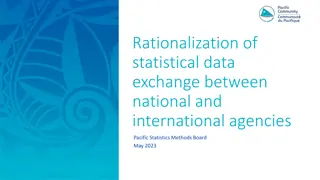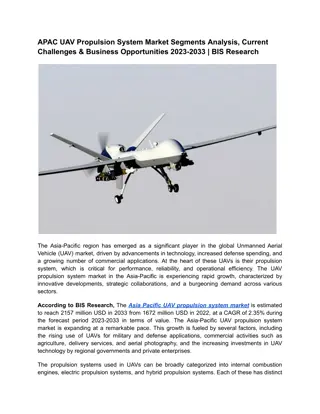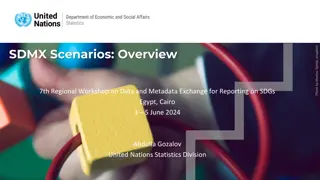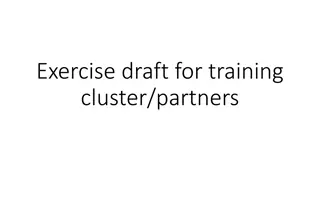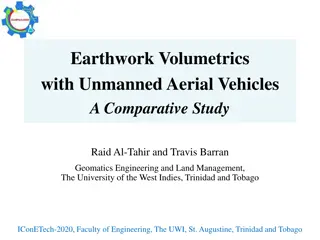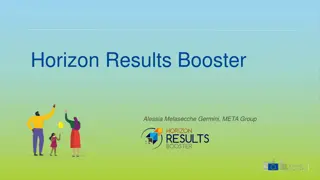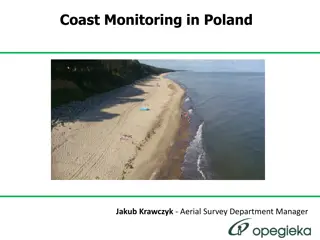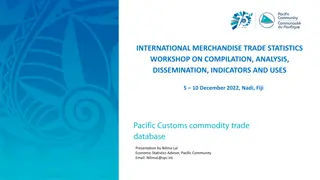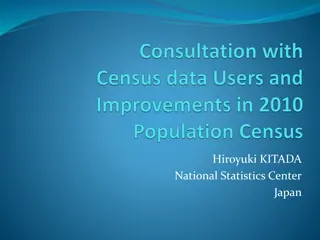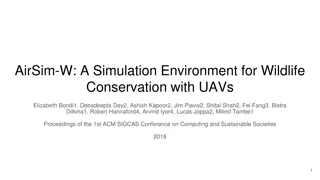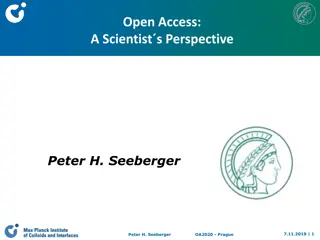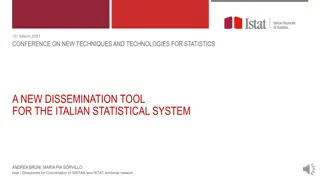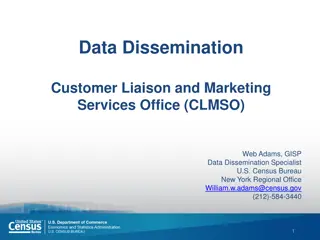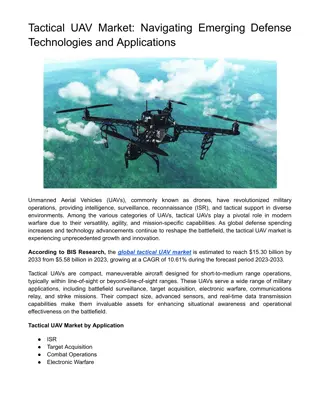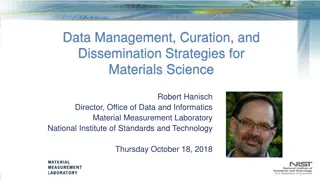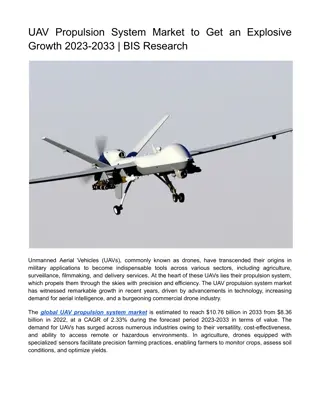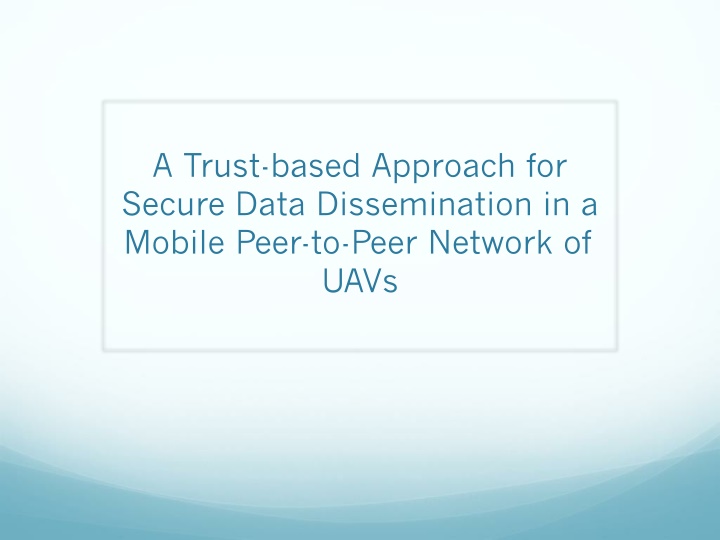
Trust-Based Secure Data Dissemination in Mobile UAV Networks
Explore a trust-based approach for secure data dissemination in a mobile peer-to-peer network of unmanned aerial vehicles (UAVs), addressing interception risks and ensuring mission success. The proposed scheme involves trust evaluation, active bundle creation, and dynamic trust calculation for effective data protection and filtering.
Download Presentation

Please find below an Image/Link to download the presentation.
The content on the website is provided AS IS for your information and personal use only. It may not be sold, licensed, or shared on other websites without obtaining consent from the author. If you encounter any issues during the download, it is possible that the publisher has removed the file from their server.
You are allowed to download the files provided on this website for personal or commercial use, subject to the condition that they are used lawfully. All files are the property of their respective owners.
The content on the website is provided AS IS for your information and personal use only. It may not be sold, licensed, or shared on other websites without obtaining consent from the author.
E N D
Presentation Transcript
A Trust-based Approach for Secure Data Dissemination in a Mobile Peer-to-Peer Network of UAVs
Problem Statement Mobile peer-to-peer networks of unmanned aerial vehicles (UAVs) have become significant in collaborative tasks including military missions and search and rescue operations Data communication (over shared media) between the nodes in a UAV network makes the disseminated data prone to interception by malicious parties, which could cause serious harm for the designated mission of the network A scheme for secure dissemination of data between UAV nodes is needed
Proposed Data Protection Scheme Trust Evaluation Server Producer Consumer Application Security Server Filtered Data 1.Data producer UAV (publisher) invokes its data sharing application 2.The application gets the desired data from the data folder and bundles it along with the policy for data protection in the protection structure proposed (active bundle) 3.The active bundle consults trusted third party services to determine the trust level of the destination UAV(consumer) 4.The active bundle filters its data based on the trust level of the consumer and the matching of policies between the producer and consumer and presents the filtered data to the consumer. Data Protection Mechanism (Active Bundle) Identity Management Middleware Services provided by Trusted Third Parties Data Folder 3
Active Bundle Structure Metadata: Identity information (owner, etc.) Data integrity checks Control access policies Dissemination policies Life duration ID of a trust server ID of a security server App-dependent information Data Content: Document files, etc. Metadata Sensitive Data Virtual Machine (algorithm): Interprets metadata Checks active bundle integrity Enforces access and dissemination control policies Virtual machine 4
Dynamic Trust Calculation The trust calculation component works like a reputation system, where the trustworthiness of a node is evaluated based on various dynamic parameters Trust parameters vary with the scenario in which the UAVs communicate, and have different weights Computed trust value is used to determine whether it is safe to share the data and the degree of filtering to apply on the data before sharing Trust value T for a particular UAV u at time t also depends on previous interactions with that UAV and is calculated using the below formula, where determines how important previous interactions are and P is the trust value determined by the dynamic parameters Tu u(t t) = Tu u(t t-1) + (1- ) P
Trust Evaluation Trust level for the destination UAV (data consumer) can be evaluated and verified by a Trusted Third Party and can be based on different parameters such as: Location Location: USA, Middle East, Iraq, etc Security Clearance Level Security Clearance Level: Top-secret, Secret, Confidential, Unclassified Bandwidth Bandwidth: High Bandwidth, Low Bandwidth History of Obligations History of Obligations: Satisfactory, Unsatisfactory Distance Distance: Not necessarily based on metric distance, i.e. more trusted entities are closer Authentication Level Authentication Level: Fully authenticated, Partially authenticated, Not authenticated Context Context: Emergency, Disaster, Normal etc.
Example of Data Filtering EPHI (Electronic Private Health Information): (Electronic Private Health Information): Stored in Stored in a relational database, data filtering for different data a relational database, data filtering for different data consumers performed through SQL queries run in the Active Bundle VM consumers performed through SQL queries run in the Active Bundle VM EPHI a. Data consumer verified as doctor at the hospital can get all patient data b. Hospital Receptionist gets filtered data c. Insurance company gets only the minimal required data
Image Data Filtering Techniques Low Dynamic Range Rendering Low Dynamic Range Rendering: This method applies the reverse of high dynamic range rendering on an image to degrade image quality and hide details. Pattern Recognition and Blurring Pattern Recognition and Blurring: This method involves recognition of specific patterns in the image to black out those high sensitivity areas. Data Equivalence Techniques Data Equivalence Techniques: Image can be transformed such that the information content of the image remains the same while the fine grain details change (such as replacing the model number of an aircraft with another model s).
Data Dissemination Models Direct Link Direct Link: UAVs discover each other through broadcast of ALIVE messages and initiate data transfer without involvement of third-party nodes. Publish Publish- -Subscribe party (ground controller) called the information broker (IB) to mediate data dissemination between UAVs. The publisher node registers an active bundle with the IB and subscriber receives data from IB after evaluation of its trustworthiness by the IB. Subscribe: This model requires a third- ?
Simulation ? ? Fig.b. Policy of data sharing is at the top, original data in the middle and the virtual machine status at the bottom. Policy is based on the trust level of the AV: If above 2.5, original data is shared; if below 2.5 but above 2.3, minimal filtering is applied; if between 2.3 and 2.0 greater filtering is applied and if below the threshold of 2.0, no data is shared, in which case the active bundle destroys itself. Fig. a. UAV Network. Data transfer is initiated from UAV3 to UAV1. Available bandwidths are displayed on the lines connecting pairs of AVs. Fig.d. Data transformed by the virtual machine according to the policy and the transformed data shared with the receiver node. The data shared provides a narrower view of the environment than the original image. Fig.c. The trust level of the receiver AV is calculated as 2.09, which is higher than the threshold trust level, but not high enough to share the ? ? original data.


